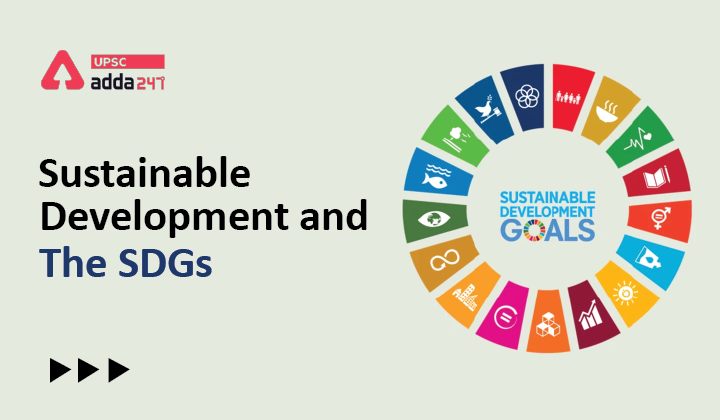Table of Contents
Sustainable Development: Relevance
- GS 3: Conservation, environmental pollution and degradation, environmental impact assessment.
This will be a 2-article series. In this article, we will discuss the concept of sustainable development and its evolution. In the next article, we will discuss the UN 17 SDGs. Both the articles are very important for all the phases of UPSC CSE 2022— prelims, mains and interview.
What is sustainable development?
- Sustainable development can be defined as the development that meets the needs of the present, without compromising the ability of future generations to meet their own needs.
Sustainable development dimensions
According to United Nations, there are four dimensions to sustainable development – society, environment, culture and economy – which are intertwined, not separate.
- Environmental Dimension: Sustainable development promotes rational use of natural resources. It promotes the use of renewable source of energy as a replacement to the conventional sources of energy like coal.
- Economic dimension: Sustainable development focuses on equal economic growth that generates wealth for all, without harming the environment. It advocates poverty eradication in all its forms.
- Social dimension: The focus of sustainable development is far broader than just the environment. It’s also about ensuring a strong, healthy and just society. This means meeting the diverse needs of all people in existing and future communities, promoting personal wellbeing, social cohesion and inclusion, and creating equal opportunity.
- Cultural dimension: From cultural heritage to cultural and creative industries, culture is both an enabler and a driver of the economic, social and environmental dimensions of sustainable development.
Sustainable development origin
- The concept of sustainable development received its first major international recognition in 1972 at the UN Conference on the Human Environment held in Stockholm.
- Though, the term was not referred to explicitly, but nevertheless the international community agreed to the notion that both development and the environment could be managed in a mutually beneficial way.
- The term ‘Sustainable Development’ was popularised 15 years later in Our Common Future, the report of the World Commission on Environment and Development
- The 1987 Bruntland Commission Report, Our Common Future described sustainable development as “development that meets the needs of the present without compromising the ability of future generations to meet their own needs.”
- The concept of sustainable development formed the basis of the United Nations Conference on Environment and Development held in Rio de Janeiro in 1992.
- More recently, the World Summit on Sustainable Development was held in Johannesburg in 2002 to assess progress since Rio.
- The Johannesburg Summit delivered three key outcomes: a political declaration, the Johannesburg Plan of Implementation, and a range of partnership initiatives. Key commitments included those on sustainable consumption and production, water and sanitation, and energy.
Note: World Summit on Sustainable Development is different from World Sustainable Development Summit. While the former was held last in 2002 (as discussed above), the latter is an annual flagship event of The Energy & Resources Institute (TERI) to provide long-term solutions for the benefit of global communities by assembling the world’s most enlightened leaders and thinkers on a single platform.
In the next article, we will discuss the UN 17 Sustainable Development Goals.
Also Read:
| Women in STEM | SPIN scheme | Shoonya Campaign | Arsenic Found in Wheat, Potato in Rural Bihar |
| Reforms in Urban Planning Capacity in India | Trade and Development Report 2021 | Trade and Development Report 2021 | Euro Green Bond |
| The History of Backward Classes Commission And the Sub-Categorisation of OBCs | Elderly Population Of India: Expert Committee On Longevity Finance | Impact of US Inflation in India | Pradhan Mantri Awas Yojana- Gramin |
| India Rejects WTO Draft on Fishery Subsidy | Supreme Court Allows Legal Sand Mining in Rajasthan | ADR Report on Political Donations | Delhi Declaration on Afghanistan |





 TSPSC Group 1 Question Paper 2024, Downl...
TSPSC Group 1 Question Paper 2024, Downl...
 TSPSC Group 1 Answer key 2024 Out, Downl...
TSPSC Group 1 Answer key 2024 Out, Downl...
 UPSC Prelims 2024 Question Paper, Downlo...
UPSC Prelims 2024 Question Paper, Downlo...





